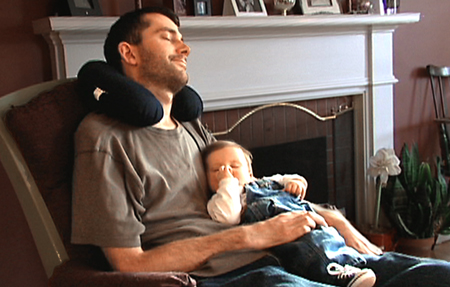|
Reviews of Recent Independent, Foreign, & Documentary Films in Theaters and DVD/Home Video
Produced, Written & Directed by: Steven Ascher & Jeanne Jordan. Director of Photography: Steven Ascher. Edited by: Jeanne Jordan. Music: Sheldon Mirowitz. Released by: Balcony Releasing. Country of Origin: USA. 87 min. Not Rated. Almost anyone with a family will be drawn into this frank longitudinal portrait of one family convinced that every problem has a solution as they face a mortal deadline. Supplemented by home movies and photos, directors Steven Ascher and Jeanne Jordan document five stressful years with the Heywood family of Newton, MA. Middle son Stephen was diagnosed at age 29 with amyotrophic lateral sclerosis (ALS), a progressive wasting away of brain and spinal column nerve cells, which mostly famously struck Lou Gehrig and Stephen Hawking. The average is five years from diagnosis to total incapacitation. An older brother, Jamie, spearheads the research group ALS Therapy Development Foundation to discover cures for Stephen. The film quickly introduces the The New Yorker profile, expanded into the book His Brother's Keeper: A Story from the Edge of Medicine by Jonathan Weiner, which first captured the filmmakers’ notice for the foundation’s work on issues surrounding failed gene therapy, orphan drugs and medical research organizations. What follows is an intense demonstration of family love combined with the faith that “technology will rock,” supporting why the independent Stephen, despite bouts of depression, remains optimistic. Throughout his illness, he continues to renovate houses. He was diagnosed as he was courting Wendy, and he was clear from the start that he wanted to have a child immediately. (Like 90% of people with ALS, his condition is not inheritable.) There is a continuing ironic counterpoint of the birth and growth of his son as Stephen loses abilities that the baby acquires, from controlled movement to walking and talking, through which the viewer infers the passing of time. The film is also notable for the one of the most powerful relationships between brothers outside of a Bruce Springsteen song ("Highway Patrolman"), a subject not usually captured in films and recently viewed ex post facto in Sean McGinly's recent documentary Brothers Lost: Stories of 9/11. Like a driven character out of a Werner Herzog film ignoring reality and the impossible, entrepreneurial Jamie is determined to save his brother’s life. Setting up the foundation, he displays all the classic signs of founder’s syndrome, where an obsessive, charismatic person starts a guerrilla organization, pulls in family and friends, attracts large donors quickly, sees its growth mushroom from the basement to a large facility, and can’t quite deliver on all his salesmanship. Even as the organization has serious cash flow problems to manage its innovative drug testing with mice, he is estranged from his wife and child, up all hours tinkering away on a gadget that will enable a deteriorating Stephen to manipulate the computer mouse for the brothers’ weekly video games night. (Their youngest sibling, Ben, keeps his sanity and personal relationships intact by staying in California and competing in the games long distance). With a story that is stronger than how it is told, the accent here is less on journalistic substance than on the individuals and the family, including the brothers’ wives and devoted parents, as they are extraordinarily open to the filmmakers on every aspect of their lives. The filmmakers not only have a personal stake in the topic, with a prologue about Jordan’s mother dying of ALS shortly after being featured in their previous, award-winning documentary Troublesome Creek: A Midwestern, but they become more and more involved with the Heywoods. At one point, Ascher understands Stephen’s faltering speech better than his own mother can. But with too much narration, the filmmakers get bogged down in elegies about time passing, yet they viscerally show us how frustrating a five-month delay can be in obtaining a super high-tech speedy wheelchair. Furthermore, the filmmakers are as naïve as Jamie, who, at a neuroscience conference, appears overwhelmed and confused about how professional gatherings of thousands of scientists work. We only get a brief glimpse of any expert outside the family. One scientist takes on Jamie in a verbal joust about the value of delaying the release of research findings to allow for peer review, but his later concession about Jamie’s points on open sourcing drug testing seems for the benefit of the camera. At one point, the foundation, suffering growing pains, does bring in a consultant to try and facilitate more realistic goal-setting, but the filmmakers do not provide interviews or insights with any other organization working on ALS which would have a more institutional perspective, seemingly to be as dismissive, like Jamie, of pharmaceutical companies as only profit-driven and academic scientists as too slow and conservative.
As it avoids being yet another inspiring film about a family overcoming huge obstacles, So Much So Fast will particularly appeal to viewers who know someone with ALS or a deteriorating disease. For classroom discussion of the human being behind the disease, it should be essential for academic libraries of institutions with programs in nonprofit management, social work, and medical research. Nora Lee Mandel
|

